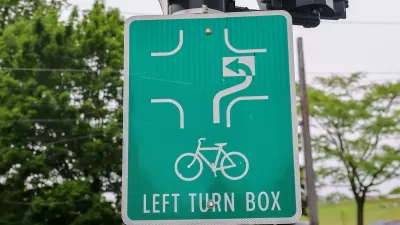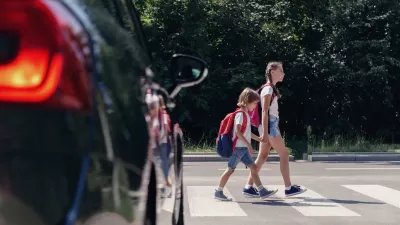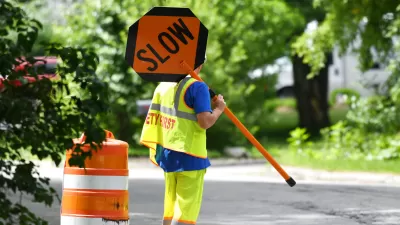The association's proposed changes to the manual include a focus on eliminating road deaths, improving pedestrian safety, and creating a more inclusive public process.

The National Association of City Transportation Officials (NACTO) has published a set of recommendations for updating the Manual on Uniform Traffic Control Devices (MUTCD) "into a proactive, multimodal safety regulation" as the Federal Highway Administration (FHWA) moves to update the document.
According to NACTO, "a reframed MUTCD is instrumental in pushing for safer, more sustainable, and equitable streets." Their recommended changes, based on "a full review of the MUTCD’s draft 11th edition with engineers, planners, and other practitioners across [NACTO's] member network," include:
- "Elevate the goal of eliminating serious injuries and deaths"
- "Modernize speed limits"
- "Make it safer to cross the street"
- "Promote people over robots on our streets"
- "Legalize commonsense treatments for people walking, biking, and taking transit"
- "Uplift best practices for bikeways, rather than prohibiting them"
- "Listen to more voices"
NACTO argues that "[i]ncorporating these comments would form the basis of a reframed, rewritten, and renewed MUTCD that prioritizes safety and the needs of more people on our streets." They also encourage the FHWA to prioritize a "more inclusive process for updating the MUTCD" that strives to understand the needs of communities that may not be able to take part in the current public comment process. "NACTO staff, and staff in our 89 member cities, were in the position to contribute hundreds of hours of time and expertise to inform the comments we’re submitting. But, many other key stakeholders affected by the MUTCD, including advocates for youth, elderly, and/or disabled, and climate, equity, and public health experts (overstretched at this time of many overlapping crises), do not have this time. The MUTCD will be a weaker document without their valuable input."
FULL STORY: A Blueprint to Update America’s Street Manual

Manufactured Crisis: Losing the Nation’s Largest Source of Unsubsidized Affordable Housing
Manufactured housing communities have long been an affordable housing option for millions of people living in the U.S., but that affordability is disappearing rapidly. How did we get here?

Americans May Be Stuck — But Why?
Americans are moving a lot less than they once did, and that is a problem. While Yoni Applebaum, in his highly-publicized article Stuck, gets the reasons badly wrong, it's still important to ask: why are we moving so much less than before?

Using Old Oil and Gas Wells for Green Energy Storage
Penn State researchers have found that repurposing abandoned oil and gas wells for geothermal-assisted compressed-air energy storage can boost efficiency, reduce environmental risks, and support clean energy and job transitions.

Updating LA’s Tree Rules Could Bring More Shade to Underserved Neighborhoods
A new USC study finds that relaxing Los Angeles’ outdated tree planting guidelines could significantly expand urban tree canopy and reduce shade disparities in lower-income neighborhoods, though infrastructure investments are also needed.

California's Canal Solar Projects Aim to Conserve Resources and Expand Clean Energy
California’s Project Nexus has begun generating electricity from solar panels installed over irrigation canals, with researchers and state agencies exploring statewide expansion to conserve water and boost clean energy production.

HHS Staff Cuts Gut Energy Assistance Program
The full staff of a federal program that distributes heating and cooling assistance for low-income families was laid off, jeopardizing the program’s operations.
Urban Design for Planners 1: Software Tools
This six-course series explores essential urban design concepts using open source software and equips planners with the tools they need to participate fully in the urban design process.
Planning for Universal Design
Learn the tools for implementing Universal Design in planning regulations.
Heyer Gruel & Associates PA
City of Moreno Valley
Institute for Housing and Urban Development Studies (IHS)
City of Grandview
Harvard GSD Executive Education
Salt Lake City
NYU Wagner Graduate School of Public Service
City of Cambridge, Maryland





























